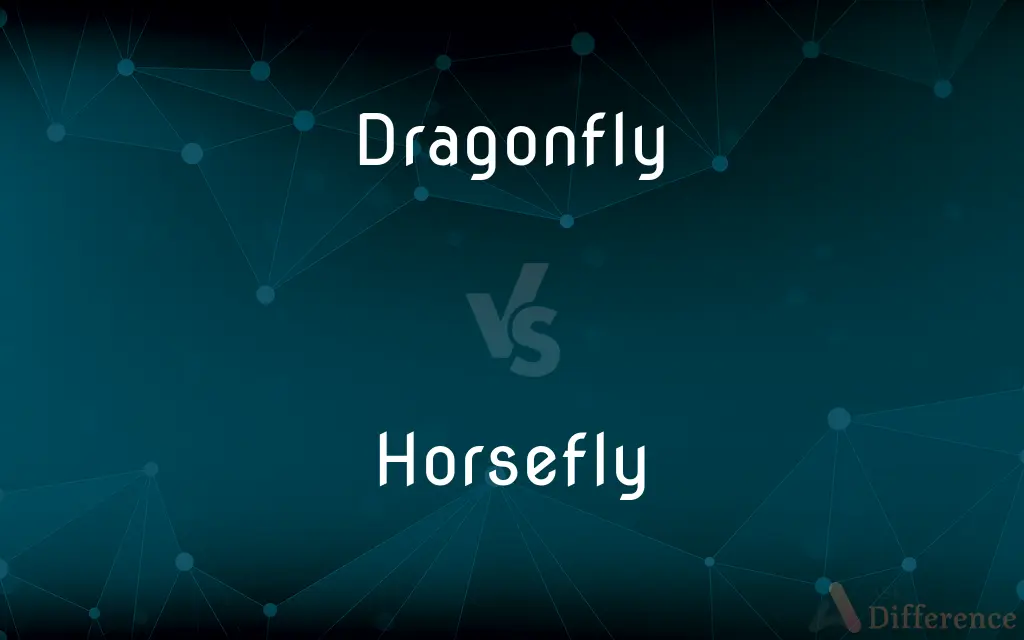Dragonfly vs. Horsefly — What's the Difference?
By Tayyaba Rehman & Fiza Rafique — Updated on April 25, 2024
Dragonflies are predatory insects known for their agility in flight, feeding on other insects, while horseflies, larger and robust, bite mammals, including humans, to feed on blood.

Difference Between Dragonfly and Horsefly
Table of Contents
ADVERTISEMENT
Key Differences
Dragonflies are recognized for their slender bodies and long wings, often found near water bodies as their larvae are aquatic. On the other hand, horseflies possess a sturdier build and are not as dependent on aquatic environments, though their larvae also thrive in moist areas.
Dragonflies have compound eyes that cover most of their head, providing them with exceptional vision to detect prey during flight. Conversely, horseflies have prominent eyes too, but their vision supports their need to locate mammals from which to draw blood.
In terms of behavior, dragonflies are harmless to humans, engaging in beneficial acts like controlling mosquito populations. Horseflies, however, are notorious for their painful bites, impacting both humans and livestock, often leading to allergic reactions.
Regarding lifespan, dragonflies generally live a few weeks to several months as adults, engaging actively in their ecosystems. Whereas horseflies have a shorter adult lifespan, focusing primarily on reproduction and feeding during this time.
Dragonflies undergo a fascinating transformation process known as incomplete metamorphosis, where they morph from larval to adult stages, closely resembling their final form throughout. Horseflies also undergo metamorphosis but their larval stage is spent hidden in moist soil or marshes, significantly different from their adult aerial activities.
ADVERTISEMENT
Comparison Chart
Size and Build
Slender and elongated body
Larger, robust body
Habitat
Prefer aquatic environments
Found in varied environments, prefer moist areas
Diet
Predatory, feeds on insects
Parasitic, feeds on blood
Interaction with Humans
Harmless, beneficial
Often harmful due to bites
Life Cycle
Undergo incomplete metamorphosis, aquatic larvae
Metamorphosis with terrestrial larvae
Compare with Definitions
Dragonfly
Aerial insect known for its two pairs of strong, transparent wings.
The dragonfly darted over the lake, catching mosquitoes mid-air.
Horsefly
Impacts livestock as well as humans, causing economic and health issues.
Horseflies are a nuisance for cattle, often causing weight loss and stress.
Dragonfly
Insect undergoing incomplete metamorphosis.
The dragonfly nymph slowly transformed into an adult without entering a cocoon.
Horsefly
Known for its biting behavior in females, which feed on blood.
A horsefly bit me while I was hiking through the fields.
Dragonfly
Predator of small insects, contributing to ecological balance.
Dragonflies help reduce the mosquito population by feeding on them.
Horsefly
Undergoes a complete metamorphosis with terrestrial larvae.
Horsefly larvae can be found buried in moist soil until they mature.
Dragonfly
Found predominantly near water due to aquatic larvae.
You can often spot dragonflies near ponds, where their larvae develop.
Horsefly
Larger than most flies, robust in form.
The horsefly’s robust body helps it survive various environmental conditions.
Dragonfly
Characterized by an elongated body and large compound eyes.
The dragonfly’s compound eyes allow it to see in almost every direction.
Horsefly
Can be a vector for diseases due to its bloodsucking habits.
Horseflies can transmit pathogens through their bites.
Dragonfly
A dragonfly is an insect belonging to the order Odonata, infraorder Anisoptera (from Greek ἄνισος anisos, "unequal" and πτερόν pteron, "wing", because the hindwing is broader than the forewing). Adult dragonflies are characterized by large, multifaceted eyes, two pairs of strong, transparent wings, sometimes with coloured patches, and an elongated body.
Horsefly
A stoutly built fly, the female of which is a bloodsucker and inflicts painful bites on horses, humans, and other large mammals.
Dragonfly
Any of numerous predatory insects of the order Odonata, having large eyes, a long slender body, and two pairs of transparent veined wings, especially those of the order Anisoptera, which hold the wings outstretched when at rest, as distinguished from the damselflies. Also called regionally darner, darning needle, devil's darning needle, mosquito fly, mosquito hawk, needle, skeeter hawk, snake doctor, snake feeder, spindle.
Horsefly
Any of numerous large biting tabanid flies, the females of which feed on the blood of various mammals.
Dragonfly
An insect of the suborder Epiprocta or, more strictly, the infraorder Anisoptera, having four long transparent wings held perpendicular to a long body when perched.
Horsefly
Any of several medium to large flies, of the family Tabanidae, that suck the blood of mammals (not to be confused with Stomoxys calcitrans, the stable fly, or dog fly).
Dragonfly
Slender-bodied non-stinging insect having iridescent wings that are outspread at rest; adults and nymphs feed on mosquitoes etc.
Horsefly
Any dipterous fly of the family Tabanidæ, that stings horses, and sucks their blood.
Horsefly
The horse tick or forest fly (Hippobosca).
Horsefly
Winged fly parasitic on horses
Horsefly
Large swift fly the female of which sucks blood of various animals
Common Curiosities
What distinguishes a horsefly from other flies?
Horseflies are larger, have a robust build, and the females are known for biting mammals to feed on their blood.
Are dragonflies beneficial to the environment?
Yes, dragonflies are beneficial as they help control populations of harmful insects such as mosquitoes.
What is a dragonfly?
A dragonfly is an insect known for its swift flying and ability to prey on other insects.
How do dragonflies reproduce?
Dragonflies lay their eggs in or near water, where the larvae develop before maturing into adults.
How can you identify a horsefly bite?
A horsefly bite is typically painful, may swell, and can sometimes cause allergic reactions.
What is the lifespan of a horsefly?
Horseflies have a relatively short adult lifespan, focused primarily on reproduction and feeding.
What is the role of dragonflies in their ecosystems?
Dragonflies serve as predators to smaller insects, helping maintain ecological balance.
Why do horseflies bite?
Female horseflies bite to ingest blood, which is necessary for their eggs' development.
Can dragonflies bite humans?
No, dragonflies do not bite or sting humans; they are harmless and beneficial.
How do horseflies find their prey?
Horseflies are attracted to movement and the carbon dioxide exhaled by mammals.
Where do horseflies lay their eggs?
Horseflies lay their eggs in moist environments, often on vegetation near water or in wet soil.
What environments do dragonflies prefer?
Dragonflies are commonly found near bodies of water, as their larvae are aquatic.
How do horseflies affect livestock?
Horseflies bite livestock, causing discomfort, stress, and in severe cases, can lead to decreased productivity.
What can be done to mitigate the impact of horseflies?
Measures include using insect repellents, managing wetlands to reduce breeding sites, and using protective clothing.
What is the visual capability of a dragonfly?
Dragonflies have excellent vision thanks to their large compound eyes that cover most of their head.
Share Your Discovery

Previous Comparison
Intern vs. Stagiaire
Next Comparison
Racing vs. MotorsportAuthor Spotlight
Written by
Tayyaba RehmanTayyaba Rehman is a distinguished writer, currently serving as a primary contributor to askdifference.com. As a researcher in semantics and etymology, Tayyaba's passion for the complexity of languages and their distinctions has found a perfect home on the platform. Tayyaba delves into the intricacies of language, distinguishing between commonly confused words and phrases, thereby providing clarity for readers worldwide.
Co-written by
Fiza RafiqueFiza Rafique is a skilled content writer at AskDifference.com, where she meticulously refines and enhances written pieces. Drawing from her vast editorial expertise, Fiza ensures clarity, accuracy, and precision in every article. Passionate about language, she continually seeks to elevate the quality of content for readers worldwide.
















































